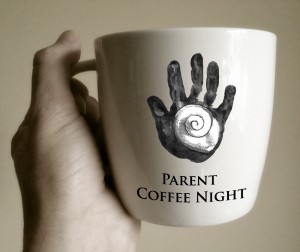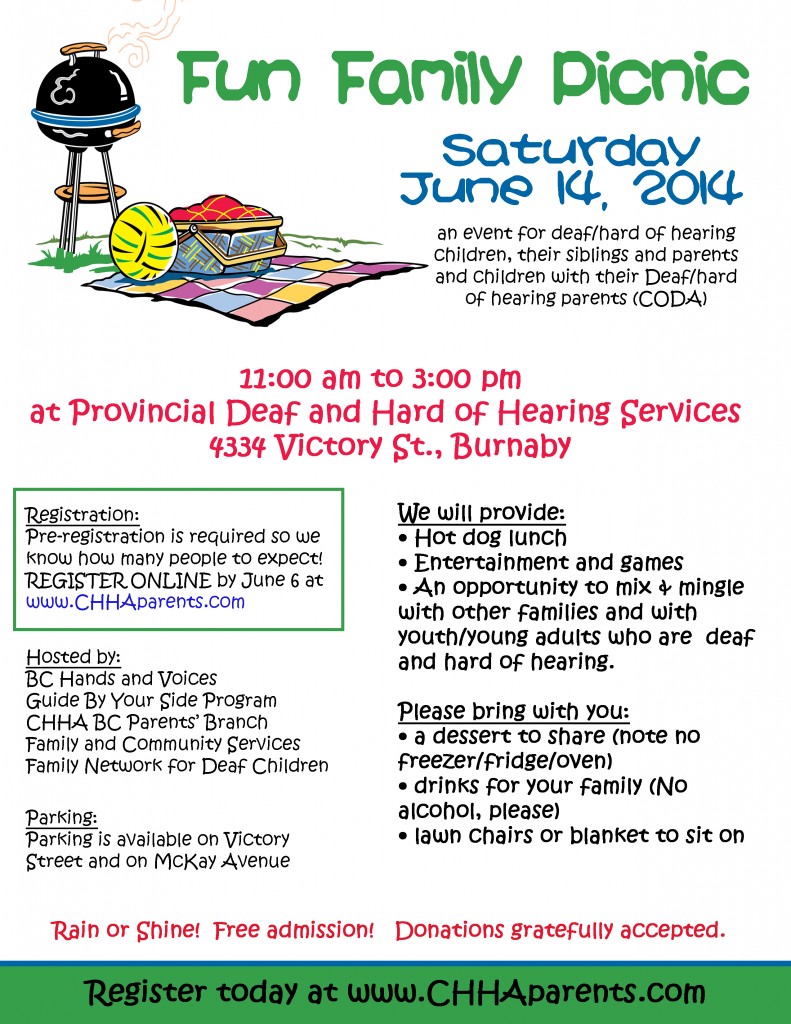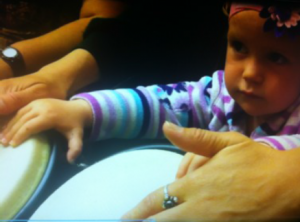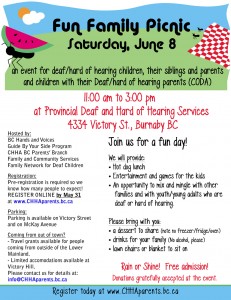Tips for Keeping Hearing Equipment on Babies, Toddlers, & Preschoolers
By Teresa Kazemir
I remember driving home from the audiologist with brand new hearing aids in a box on my lap – little did I know what lay ahead in terms of keeping hearing equipment on a baby! Some things we learned:
– Hearing aids tend to whistle whenever a baby’s head leans against something – which happens a lot when young babies are cuddled and when they sit in car seats, strollers, swings, etc.
– If babies spit up a lot while they are laying on their back, it tends to run into their hearing equipment.
– It can be tricky to find a hat that keeps the baby’s head warm, keeps the hearing aids dry, but does not make the hearing aids whistle.
– As babies get older, they like to put everything in their mouth – including their hearing equipment!
– When babies get to be toddlers, they think ripping off hearing aids and throwing them is a super fun game!
Not every deaf or hard of hearing child uses hearing equipment, and different families may have different goals in terms of how many hours each day their child wears amplification. But if your goal is for your baby, toddler or preschooler to wear their hearing equipment and you are finding it tricky – YOU ARE NOT ALONE!!
We’ve compiled some tips and websites suggested by other parents – we hope you find them helpful. (Please note: BC Hands & Voices does not endorse any particular product, nor do we benefit financially from the sale of any of the products mentioned below. These are merely suggestions based on what other parents have told us they have found helpful. Also, we recommend that you keep in mind any potential choking hazards if you are considering some of these products for a young child.)
Tip # 1 – Wig tape
Wig tape can be really helpful for keeping hearing aids or cochlear implants in place on tiny ears, especially if they are flopping around. You can usually buy it at any store that sells wigs, or you can order it online, a quick google search pulls up various sellers (e.g. https://hairtape.com/3m-1522-clear-tape/. The ½” width generally works well.
Tip #2 – Covers, Cords & Clips
There are many products available that are designed to help keep hearing equipment on an infant or young child. You may have to experiment and try a few before you find what works best for your child. Your early interventionist or audiologist might be able to request free samples for you to try. You can try the following sites, or search for “hearing aid retention” on your web browser.
Ear Gear (www.gearforears.com) – colourful water-resistant covers which can be attached to clothing with a clip. These are made in BC.
Huggies (https://www.diateccanada.com/en/huggie-aids) – can stop the aids from flipping off of the child’s ears, so they are less distracting and the child is less likely to yank them off.
Critter Clips (https://adcohearing.com/collections/ear-care-hearing-aid-supplies-clips-and-loss-prevention-clips-for-kids/products/critter-clip-bte-binauraldouble) – a lightweight lanyard attaches to the hearing aid and clips to the child’s clothing with a colourful clip (also Dino Clips and Sea Clips).
Otoclips (https://adcohearing.com/search?type=product&q=otoclip) – plain clips and cords designed to attach hearing aids to clothing.
SafeNSound security straps (www.getsafensound.com) – these fit snugly to the head and are hard for babies to reach; they can also work with glasses and they have one that connects to a hair barrette.
There are also some home-made options for keeping hearing aids attached to clothing. You can use dental floss or fishing line to connect the hearing aids and pin it to the back of the shirt. Pacifier clips can sometimes work or those cords that are meant to keep on eyeglasses – you can fit the flexible loop at the end around the hearing aid and pin the centre of the cord to the collar of the shirt.
Tip # 3 – Hats
Some families find that using a hat is a very good way to keep babies and toddlers from pulling off their hearing equipment. Homemade bonnets that tie or snap under the chin can also work well, and there are several options available on Etsy:
https://www.etsy.com/ca/search?q=bonnet%20for%20hearing%20aids
While hats can be a solution, they can also be problematic. Depending on the type of hearing equipment your child uses, some families find it challenging to find a winter hat that will keep their child’s head warm but will not cause feedback. Several parents suggest using a loose-fitting crocheted or loosely knitted hat or touque. For the rain, a loose-fitting hood on a jacket can work well. You may need to experiment to see what works best for your particular child.
Tip #4 – Headbands
Families of children who use Bone Conduction hearing aids or softband Bone Anchored hearing systems (BAHAs or Bahs) are often looking for headband options. In addition to products available through the hearing aid companies, a quick “softband” search on etsy.com turns up a multitude of colourful options for decorating and making your child’s BAHS as unique as they are! https://www.etsy.com/search?q=softband
A member from our own community shared tips for how to modify your softbands yourself. Read the article here: https://www.bchandsandvoices.com/post/how-to-customize-your-baha-soft-band/
Tip #5 – Decorations
One way to motivate young children to wear their hearing equipment is to make it bright and colourful and fun to wear. Here are some products that our readers recommend:
Skinits (www.skinit.com) – vinyl stickers specially shaped to fit on cochlear implants and are easily removable without residue. Countless designs are available.
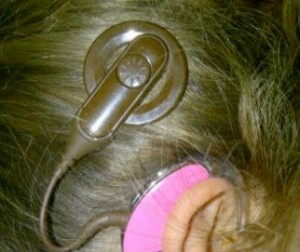
“My son loves them! It MOTIVATED him to wear both his CIs more than ever! In public places, people were raving about them, he was so proud of them! I love them. I will order them again when it’s time to replace them. They have thousands of designs to choose from!” Karen Jackson
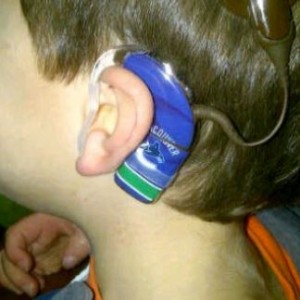
Hayleigh’s “Cherished Charms” are another decorative product, designed by a teen-aged girl who wants to help kids and adults to be proud of their hearing aids (www.hayleighscherishedcharms.com). Hayleigh’s shop was temporarily closed during the pandemic, but hopefully it opens again soon.
Tip #6 – Some Less Conventional Ideas
A less conventional idea I heard recently was to use inflatable swimming arm bands. They can be decorated with stickers or felt markers and apparently prevent a toddler from reaching his or her ears to pull the hearing aids off. This was also suggested as a strategy for making earmold impressions in the audiologist’s office.
Someone also suggested bandaids for keeping cochlear implants on during activities such as tumbling, and using a Bounce sheet inside a touque to prevent static electricity building up (also for CI’s).
Tip #7 – Distraction, Positive Reinforcement and Rewards
Distraction, positive reinforcement and rewards are very useful parenting tools. Distraction can be one of the best strategies for babies and toddlers. Many parents find it works to give the child something to keep their hands busy when they are first putting in the hearing aids. This might mean having some special toys that only come out when the hearing aids first go on or a special game that you play. Unfortunately, as parents we do not always have time to entertain our baby every waking minute, but often young children will forget about the hearing aids in their ears if they’ve been distracted by something else.
As toddlers get a little older, positive reinforcement can work well. Children may respond to praise for wearing the hearing equipment and may also start to understand that the hearing aid or CI is helpful – “Now you can hear the music!” Children also benefit from seeing other children who are like them, either in person or through books, DVD’s, or TV shows. (I remember there was a little boy on the TV show “Barney” who wore the same type of hearing aid as my son did when he was young, so we’d watch that show occasionally and I’d point out the boy’s hearing aid.) There are more and more children’s books available that feature deaf and hard of hearing characters (e.g. ‘All the Ways I Hear You’
https://www.amazon.ca/All-Ways-I-Hear-You/dp/0578598973/ref=sr_1_20?crid=237Z9P934G03D&keywords=children%27s+books+hearing+aid&qid=1677260890&sprefix=children%27s+books+hearing+aid%2Caps%2C87&sr=8-20)
And for the child who is a little older and understands the concept of a reward, you can always try candy, raisins, stickers and little dollar store toys as incentives for keeping the hearing aids on. Of course that also means finding a way to wean your child off of the incentives later, as the dentists of the world would probably frown on the idea of bribing our children with candy every time we put the hearing aids on!!
Tip #8 – Some General Resources on the Net
There are some great sites on the internet that you can look at for more ideas, such as:
Tip #9 – Check in with your Audiologist
It is always a good idea to check in with your audiologist regularly, particularly if your child is refusing to wear their hearing equipment or is responding differently than he or she has responded in the past. It’s important to make sure the earmold or hearing aid isn’t rubbing and making a sore spot and that your child doesn’t have an ear infection. The audiologist can check to make sure that the earmold is fitting correctly (babies grow out of earmolds very quickly), that the hearing aid is working properly (children will sometimes pull off a hearing aid or implant that has a dead battery or is not functioning well), and that the hearing equipment is set correctly.
Tip #10 – Give yourself a break
While your goal may be for your child to wear their hearing equipment regularly, this usually doesn’t happen overnight. Some babies are easy going, and some toddlers ask to wear their hearing equipment, and don’t want to take it off. Other children, however, go through stages where they are determined to remove the equipment the instant you put it on. Try not to get frustrated, and take time to enjoy your child without always being focused on the equipment. During times when your child may not have access through listening, you can still communicate using touch, gestures, signs, etc. If you are concerned that your child is not getting enough access to spoken language, you can talk to your early interventionist about opportunities to learn American Sign Language. You know your child best, and you’ll eventually figure out what works for them and for your family.
So if you are struggling to keep hearing equipment on your child, we hope some of these tips might be helpful. Also, we hope you realize that you are not alone in this struggle. Many parents find this stage challenging, and we encourage you to talk to other parents for both ideas and support. Come out to a BC Hands & Voices event, call your Parent Guide, ask to meet other parents through your early intervention agency or drop us a line on Facebook or by email. We can be such a great resource for one another!
